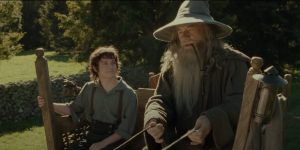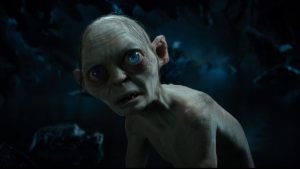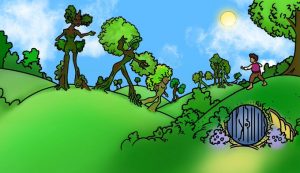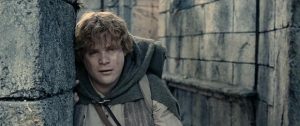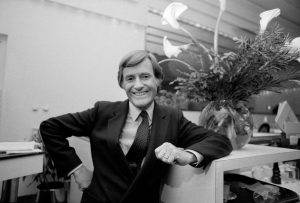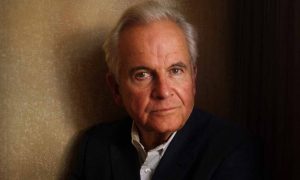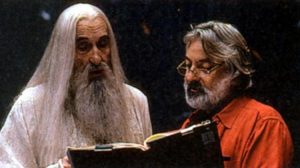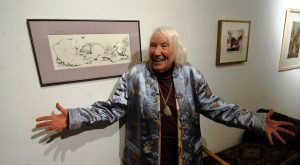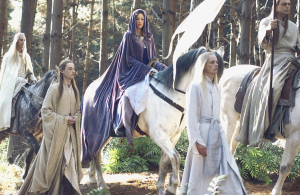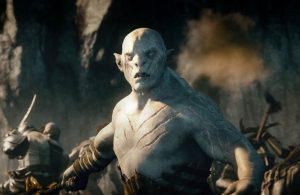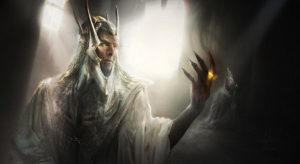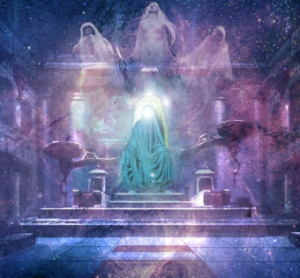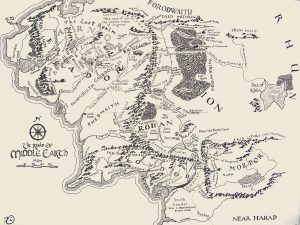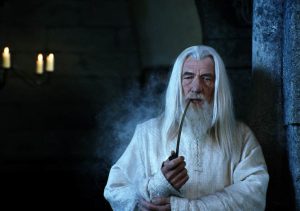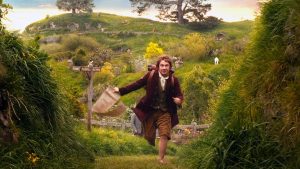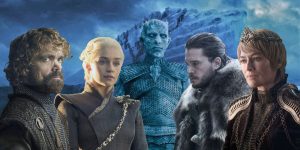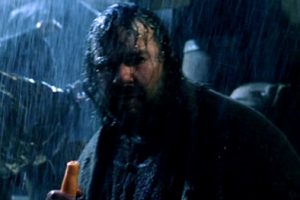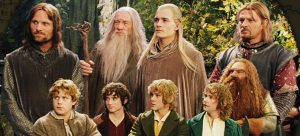In all the hype surrounding Amazon’s upcoming The Lord Of The Rings prequel series (hype that, to be honest, Amazon themselves have done little to stir up on their own with official announcements and news, relying on hardcore fans to drive interest for the past several months), it’s hard to remember sometimes that Warner Brothers and New Line Cinema still own the rights to the actual narrative of J.R.R. Tolkien’s magnum opus, The Lord Of The Rings. The situation is messy, and who owns what exactly is still not entirely clear (whether or not Amazon has permission to draw from Unfinished Tales, for instance, is a matter of heated debate in the Tolkien fandom), but Warner Brothers clearly still has enough to create an entire stand-alone feature-length anime focusing on the ancient history of Rohan.

Honestly, this is a startlingly random announcement to spring on us today of all days, without so much as a warning – Danger! Beware Of Hype Overload! Because I don’t know about you, but my hype levels are accelerating at an alarming rate, and show no sign of stopping. It’s been six years since the last film set in Tolkien’s Middle-earth came out, and that film was The Battle Of The Five Armies, so it doesn’t count. With Amazon’s The Lord Of The Rings still only dimly visible on the horizon like the far-distant peak of the Meneltarma rising above the waters of Belegaer, it makes sense for Warner Brothers to capitalize on their long delays by giving audiences a taste for what the OG makers of Middle-earth have been up to in the mean-time. Partnering with the Warner Brothers Animation department for the ambitious project, New Line has already picked out a director in anime veteran Kenji Kamiyama, and a pair of writers in Jeffrey Addiss and Will Matthews, who previously developed Netflix’s The Dark Crystal: Age Of Resistance. If you remember my feelings on that series, you probably know that their inclusion in this project sends a chill down my spine that I can’t entirely shrug off, but luckily these writers will have help from Philippa Boyens herself.
Boyens is one of the three masterminds behind The Lord Of The Rings‘ excellent screenplay, alongside Fran Walsh and her husband, Peter Jackson. While Jackson’s directing is a huge part of why the films are as good as they are and he certainly deserves credit for his accomplishments, he tends to be propped up on a pedestal by the mainstream media as the sole genius responsible for bringing Middle-earth to life – while Boyens and Walsh, both Oscar-winners, are overshadowed and largely ignored. Both women were instrumental in keeping the films as true to the source material as they could be, as well as creating some of the most iconic original lines of dialogue from the trilogy (some of Boyens’ contributions in that category include “You shall not pass”, a slight but significant deviation from the books, and “A wizard is never late, Frodo Baggins. Nor is he late. He arrives precisely when he means to.”) That’s not to say all of her work on the trilogy was perfect – she was apparently responsible for “Meat’s back on the menu, boys!”, according to Grishnákh actor Stephen Ure – but her involvement in the anime is encouraging to me.
Peter Jackson, meanwhile, is presumably still too busy navigating the fallout from a bizarre scandal in his personal life involving a vintage aircraft theft to get involved in the new film, although he apparently gives it his blessing. It’s unclear whether the anime will attempt to stay in line with Jackson’s canon anyway, although it seems fairly likely given that New Line is overseeing this project, not Amazon. That being said, the film, currently titled The Lord Of The Rings: The War Of The Rohirrim, will be set a few hundred years before Jackson’s trilogy, so the only area in which it will really be expected to adhere to his canon is in the architecture and design of certain locations.

The War Of The Rohirrim will take place in the kingdom of Rohan during the reign of Rohan’s ninth and arguably its most legendary king, Helm Hammerhand (for comparison, Théoden was the seventeenth king of Rohan, during the time period covered in The Lord Of The Rings). Helm inherited a kingdom very different from the one we saw in the trilogy: mostly due to the fact that Saruman the White had not yet settled in the ring of Isengard, nor consolidated the kingdom’s most ancient enemies into an alliance against the Rohirrim. Helm Hammerhand’s greatest foes were Freca, a powerful tyrant who lived west of Rohan in the region of Dunland, and all of his house. They claimed to be descended from Rohan’s fifth king, although Tolkien’s appendices to The Lord Of The Rings never confirm whether this claim held any weight. Either way, Freca was not very fond of Helm Hammerhand, and sought to gain power in Rohan by means of a politically-motivated marriage between his son, Wulf, and Helm’s daughter.
The marriage proposal fell through (although I won’t be surprised if it’s the central love story in The War Of The Rohirrim anyway) after Helm sucker-punched Freca in the face, killing him, and Wulf seized an opportunity to launch an attack on Rohan while the kingdom’s closest ally, Gondor, was occupied with defending their coastlines against the Corsairs of Umbar. Wulf’s Dunlending army was soon joined by warriors from the lands east of Mordor, and they drove Helm’s armies into the valley where he would fortify the foundations of an ancient Gondorian citadel which became known as Helm’s Deep. Both of Helm’s sons were killed there, but Wulf’s foes never breached the gates of the citadel. That’s an important plot-point in The Lord Of The Rings, so it can’t be altered with too much.
This siege lasted for many months, and coincided with the onslaught of the Long Winter, which left Rohan devastated by famine and blight. Tolkien describes Helm during this time as becoming increasingly dangerous and feral, venturing alone out into the snow to “slay many men with his hands”. Rumors that he had become a cannibal in his madness preceded him and sent his foes scattering whenever they heard the blast of his mighty horn from the walls of the citadel. Even when the cold finally killed him, he was found standing, frozen to death and covered in snow, on the wall. Long after his death, the ghostly echoes of his horn would still sound in the Deep, and his vengeful phantom was believed to rise again whenever Rohan was endangered.
Helm didn’t survive to see the end of the siege on Helm’s Deep, or the day when his brave young nephew Fréaláf ambushed Wulf in the Golden Hall of Meduself and achieved victory over the Dunlendings. But his legacy lived on, inspiring his descendants to great deeds of their own. The anime will have plenty of opportunities to draw parallels to the siege of Helm’s Deep in The Lord Of The Rings, where Helm’s horn marked the turn of the tide against Saruman’s armies of ravenous orcs.
And speaking of Saruman…I know I mentioned earlier that he wasn’t living in Isengard at the start of Helm’s reign, but by its end he had already taken an interest in the affairs of Rohan – assuming he hadn’t already been pulling the strings behind Freca and Wulf’s dissent. At Fréaláf’s coronation ceremony, he first appeared in Rohan and was welcomed by the Rohirrim. And with the Dunlending presence driven from Isengard, he was given free reign over the ancient stronghold and its treasure trove of magical artifacts. This ominous, almost tragic, ending would be the perfect way to tie everything back into The Lord Of The Rings proper.

So yeah, I’m definitely going to keep a close eye on this project. Voice-casting and animation is currently underway, and I’m especially interested to see the style of anime that Warner Brothers goes with, as I think that will be very important: personally, I’d be most excited for something similar to the artwork of Netflix’s Blood Of Zeus and Castlevania anime series’, both of which also come with the violence one would expect from a series following Helm Hammerhand. This could very well end up being the first R-rated Tolkien property, and I don’t know how the fandom will respond to that.
But what say you? Does The War Of The Rohirrim sound appealing to you, and would you look forward to more anime based on The Lord Of The Rings? It’s a “yes” and a resounding “yes!” from me, by the way. Share your own thoughts, theories, and opinions, in the comments below!
